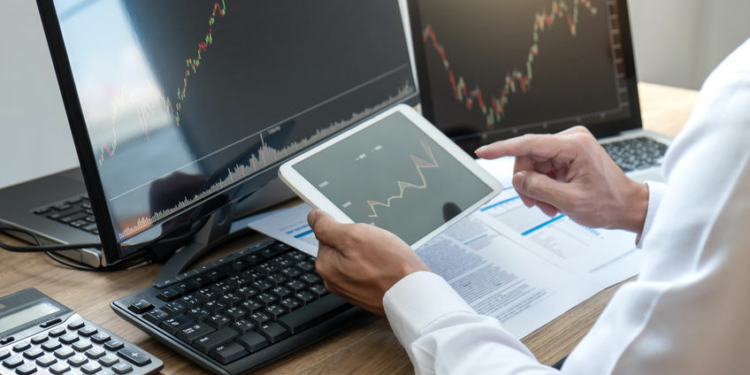Let’s start with the basics — what parameters determine a trade? Stock fluctuation is usually representable by the movement or the stock’s value in a said time. The main factors are OCHL.
OCHL stands for stock value at market open, stock value at market close, the highest price of the day, and the day’s lowest price. Chart provided by a Stock market api or your digital broker can show this value.
Outside of these, there is a fifth parameter that helps understand the value of the stock. This value is called the volume. Trading volume is the measure of the quality of financial assets traded in a given time.
In the case of the stock market, it’s measurable by the volume of shares treaded. In the case of options and futures, it is the number of hands switched by a contract.
The number that comes from this calculation works as a trading indicator.
What Is A Trade Indicator?
Indicators or trading indicators are statistics that help to either determine or forecast a trend in the market. These act as a guideline that allows the trader or investor to find potential assets to deposit their money.

These are of two kinds, economic and technical. Economic indicators help to determine the overall climate or the state of the economy. They can be as simple as the SENSEX or the value of gold.
The technical indicators, also the basis of technical analysis, are used to predict fluctuations or price-pattern changes in the market. It can be for a single entity like a stock or a group of funds.
How To Use Volume To Predict Price Patterns?
The volume of a stock can determine how strong or how much movement is present on a share. As an active (or passive) trader, you want to stick to stocks that show more activities, exchanges, and trades.
In simple words, if you visit your local store and notice more people picking up a particular brand of bread, you can assume that it’s a relatively trusted brand. This group-action will also make you more inclined to this product.
While this is no assurance that the bread will work for you, this movement is an indicator. This pattern is precisely how volume works — just as a guideline or an “indicator.” Here are some approaches:
Market Rise, Volume Rise
For the price of a stock to increase continuously, there also has to be a higher volume. This high volume means that more people are showing enthusiasm towards a particular stock.
The reduction in volume means not many people are interested. If there is a change in the price on a minimal volume of stocks, it means that this stock is not doing very well in the market.
Determine Bullishness
A bullish move in the market is the rise of a stock price because of a raised demand. This movement of the market is called a Bull rise. The opposite of this is called a bear-fall.
If the volume of the stocks increases, more people are interested in the share. This action will allow the price of the stock also to shoot up. A volume surge during a price decline will also force the price to go up.
The Reverse Effect
This effect might be slightly harder to wrap your head around.
Let’s assume the price of a stock is taking a long ride and uniformly going higher. So this value is on the upward for many hours, days, or weeks.
If you notice the price-range is starting to reduce and the volume is substantial, we can predict that the price will reverse.
The same is valid for falling prices. If the cost is continually dipping for a long time, and then the volume increase, the stock price is about to surge.
Time Dependence Of Volume
A lot of indicators and factors from any time in the stock-history can give valuable information.
For example, if you notice a stock that has reached a price of $300 many years ago. This is at the cost of $200 today; we can infer that the stock has the potential to reach that peak again.
However, volume is one such indicator that is only effective in its current time. If you look at the volume data of stock from many years ago, it will provide almost no relevance to your existing trade.
Commonly Used Volume Indicators
So far, we have talked about the effects of volume and its simple utility. To fully use volume to your advantage, we used volume indicators.
These are formulas used in charting platforms. They are not strictly a must-have feature, but they can promote better decision making.
Here are some commonly used volume indicators:
On Balance Volume:
In this process, the volume is added when the market has a high closing, and the volume is subtracted when the market has a low finish.
This effect gives the traders an idea of which stocks are accumulated at the end of the day. It can also show the relations between price rise and volume increase, or price reductions and volume decrease.
Chaikin Money Flow:
As we all know, the increase in the price of a stock should also amount to an increase in the volume. So CMF explains the volume when the prices reach one of the peak or low positions of the day.
When the closing price is higher, the volumes of the stocks are on the rise. Similarly, when the closing price is low, the volume at a trade will be low or negative.
Final Thoughts
Now that you understand all there is about volumes and indicators, it brings us to the question at hand — Are they a surefire way of predicting price patterns?
Unfortunately, there is no such thing as a surefire way of prediction. This study can spot trends and predict the movements of the values. But the actions of the market are not just affected by these five numbers.
However, keeping an eye on these indicators with platforms like Tradingview will ensure that your losses are to a minimum; your odds of a profit are higher.




Discussion about this post